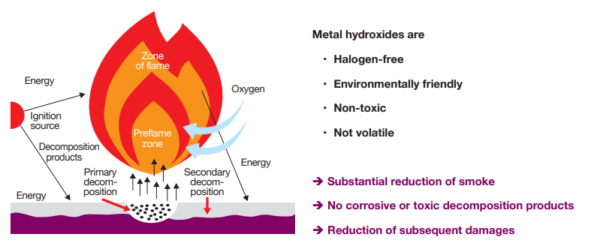Non-Halogenated Flame Retardants in Electrical & Electronic Components

Non-halogenated flame-retardant developments are driving a transformative shift in the global market, challenging traditional flame retardants that often lead to toxic emissions.
You can also read: Embracing Sustainability With Bio-based Flame Retardants
Cable and Wire applications
Cables play a crucial role in the modern world, and their flammability, smoke density, and toxicity during fires have become key considerations concerning “end-of-life” scenarios. Simultaneously, compliance with Waste Electrical and Electronic Equipment (WEEE) and Restriction of Hazardous Substances (RoHS) directives has become essential.
Key flame retardants, such as aluminum hydroxide (ATH), aluminum-oxide-hydroxide (AOH), magnesium hydroxide (MDH), and nanocomposites, address concerns surrounding cable design.

The mechanism of metal hydroxides as flame retardant. Courtesy of Pinfa.edu.
Flame Retardants in Electronic Enclosures
The electronic enclosures market, housing devices, and information technology equipment like televisions and computers, uses polymer resins such as high-impact polystyrene (HIPS), acrylonitrile butadiene styrene copolymers (ABS), and polycarbonate (PC). Meeting strict fire safety standards, such as UL 94 V, requires incorporating flame retardants into the polymer compounds.
The Waste Electrical and Electronic Equipment (WEEE) Directive compels manufacturers to assess their product life cycles, leading to increased adoption of environmentally friendly flame retardants such as triaryl phosphate (TPP, RDP, BDP, Resorcinol 2.6) to align with sustainability goals.
Flame Retardants for Enhanced Electrical Component Safety
Connectors and switches are pivotal in various electrical components, and most of them are made of plastics, due to their electrical and thermal insulation properties. However, as plastics are mostly derived from fossil fuels, they can easily ignite when exposed to heat or flames. Therefore, fire safety is crucial, especially for components exposed to heat due to electricity use.
Adding Non-Halogen flame retardants to electrical devices enhances safety and environmental friendliness while preserving component properties. For instance, metal phosphinates, constituting about 20% in glass fiber-reinforced polyamides and polyesters, exhibit low water affinity and excellent thermal stability, making them compatible with lead-free soldering operations.
Environmental Compliance in Printed Wiring Boards
Printed Wiring Boards (PWBs) constitute integral elements of electronic devices, demanding fire resistance for compliance with safety standards. The formulation of PWB base materials, typically using epoxy resins, has undergone alterations in response to the Restriction of Hazardous Substances in Electrical and Electronic Equipment (RoHS) (RoHS, 2002/95/ EC, and RoHS 2, 2011/65/EU) set by the European Union.
These regulations aim to restrict the use of hazardous substances in electronic equipment to safeguard the environment and public health.
To comply with the ongoing transition, the International Electronics Manufacturing Initiative (iNEMI) conducted a comprehensive investigation, comparing non-halogenated laminates with brominated materials. The study yielded valuable insights, including positive findings in material testing. Consequently. laminate properties exhibited good thermal stability, comparable moisture absorption, no impact of fillers on adhesion and bake/reflow electrical testing (Dk/Df), did not significantly alter the laminate dielectric constant.
In the end, the workgroup determined that the essential electrical and thermo-mechanical properties of the HFFR laminates satisfy the requirements, and the electronics industry is prepared for this transition.
You can check the final iNEMI report here.
